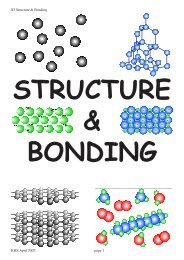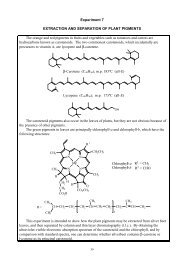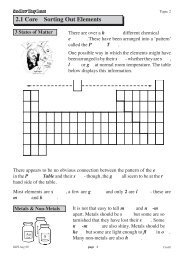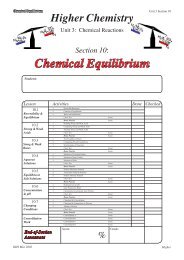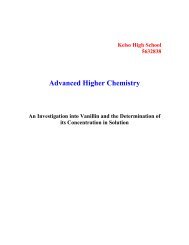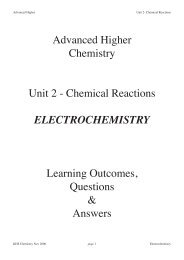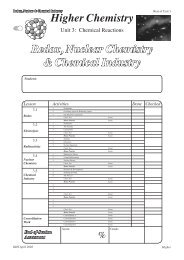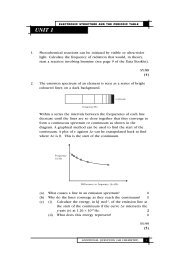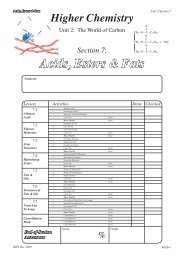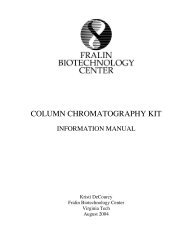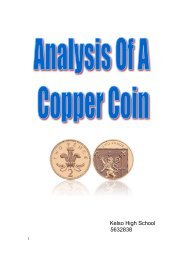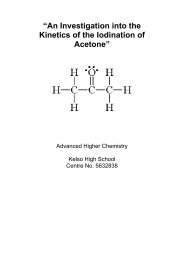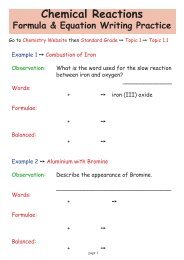2003 Chemistry Higher Finalised Marking Instructions - eduBuzz
2003 Chemistry Higher Finalised Marking Instructions - eduBuzz
2003 Chemistry Higher Finalised Marking Instructions - eduBuzz
You also want an ePaper? Increase the reach of your titles
YUMPU automatically turns print PDFs into web optimized ePapers that Google loves.
<strong>2003</strong> <strong>Chemistry</strong><br />
<strong>Higher</strong><br />
<strong>Finalised</strong> <strong>Marking</strong> <strong>Instructions</strong>
<strong>Higher</strong> <strong>Chemistry</strong><br />
General information for markers<br />
The general comments given below should be considered during all marking.<br />
1 Marks should not be deducted for incorrect spelling or loose language as long as the meaning of<br />
the word(s) is conveyed.<br />
Example: Answers like 'distiling' (for 'distillation') and 'it gets hotter' (for 'the temperature rises')<br />
should be accepted.<br />
2 A right answer followed by a wrong answer should be treated as a cancelling error and no marks<br />
should be given.<br />
Example: What is the colour of universal indicator in acid solution?<br />
The answer 'red, blue' gains no marks.<br />
3 If a right answer is followed by additional information which does not conflict, the additional<br />
information should be ignored, whether correct or not.<br />
Example: Why can the tube not be made of copper?<br />
If the correct answer is related to a low melting point, 'It has a low melting point and<br />
is coloured grey' would not be treated as having a cancelling error.<br />
4 Full marks are usually awarded for the correct answer to a calculation on its own; the part marks<br />
shown in the marking scheme are for use when working is given. An exception is when<br />
candidates are asked to ‘Find, by calculation, …..’.<br />
5 A half mark should be deducted in a calculation for each arithmetic slip.<br />
6 A half mark should be deducted for incorrect or missing units only when stated in the marking<br />
scheme. No marks should be deducted for incorrect or missing units at intermediate stages in a<br />
calculation.<br />
7 Where a wrong numerical answer (already penalised) is carried forward to another step, no<br />
further penalty is incurred provided the result is used correctly.<br />
8 Ignore the omission of one H atom from a full structural formula provided the bond is shown.<br />
9 With structures involving an –OH or an –NH2 group, a half mark should be deducted if the 'O' or<br />
'N' are not bonded to a carbon, i.e. OH–CH2 and NH2–CH2.<br />
10 When drawing structural formulae, a half mark should be deducted if the bond points to the<br />
'wrong' atom, eg<br />
OH<br />
C C<br />
11 A symbol or correct formula should be accepted in place of a name unless stated otherwise in<br />
the marking scheme.<br />
12 When formulae of ionic compounds are given as answers it will only be necessary to show ion<br />
charges if these has been specifically asked for. However, if ion charges are shown, they must be<br />
correct. If incorrect charges are shown, no marks should be awarded.<br />
Page 2
13 If an answer comes directly from the text of the question, no marks should be given.<br />
Example: A student found that 0·05 mol of propane, C3H8 burned to give 82·4 kJ of energy.<br />
C3H8(g) + 5O2(g) 3CO2(g) + 4H2O(l)<br />
Name the kind of enthalpy change which the student measured.<br />
No marks should be given for 'burning' since the word 'burned' appears in the text.<br />
14 A guiding principle in marking is to give credit for (partially) correct chemistry rather than to<br />
look for reasons not to give marks.<br />
Example 1: The structure of a hydrocarbon found in petrol is shown below.<br />
mark.<br />
Name the hydrocarbon.<br />
CH3<br />
CH3 CH2 CH CH2 CH2 CH3<br />
Although the punctuation is not correct, '3, methyl-hexane' should gain the full<br />
Example 2: A student measured the pH of four carboxylic acids to find out how their strength is<br />
related to the number of chlorine atoms in the molecule. The results are shown.<br />
Structural formula pH<br />
CH3COOH 1·65<br />
CH2ClCOOH 1·27<br />
CHCl2COOH 0·90<br />
CCl3COOH 0·51<br />
How is the strength of the acids related to the number of chlorine atoms in the<br />
molecule?<br />
Although not completely correct, an answer such as 'the more Cl2, the stronger the<br />
acid' should gain the full mark.<br />
15 Unless the question is clearly about a non-chemistry issue, eg costs in industrial chemistry, a<br />
non-chemical answer gains no marks.<br />
Example: Why does the (catalytic) converter have a honeycomb structure?<br />
A response such as 'to make it work' may be correct but it is not a chemical answer<br />
and the mark should not be given.<br />
16 When it is very difficult to make a decision about a partially correct answer, a half mark can be<br />
awarded.<br />
17 When marks have been totalled, a half mark should be rounded up.<br />
Page 3
<strong>2003</strong> <strong>Chemistry</strong> <strong>Higher</strong><br />
<strong>Marking</strong> Scheme<br />
Section A<br />
1. C 11. D 21. A 31. D<br />
2. D 12. A 22. C 32. B<br />
3. B 13. B 23. D 33. A<br />
4. C 14. D 24. D 34. D<br />
5. D 15. C 25. A 35. B<br />
6. B 16. C 26. D 36. D<br />
7. C 17. A 27. C 37. C<br />
8. B 18. C 28. A 38. C<br />
9. C 19. A 29. B 39. A<br />
10. D 20. B 30. A 40. B<br />
Page 4
Mark Scheme Worth ½ Worth 0<br />
2,3–methylpentane<br />
or<br />
methylpentane<br />
2-methyl, 3-dimethylpentane<br />
or<br />
3,3,4–trimethylpentane<br />
or<br />
2,3,3–methylpentane<br />
1. (a) 2,3,3–trimethylpentane<br />
or<br />
3,3,2–trimethlypentane<br />
(commas, dash may be omitted) 1<br />
naphtha<br />
or<br />
ring structure<br />
or<br />
cyclic phenol<br />
(b) cycloalkanes<br />
or<br />
aromatics (benzenes)<br />
or<br />
benzyl hydrocarbons 1<br />
(2)<br />
Page 5
Mark Scheme Worth ½ Worth 0<br />
light<br />
or<br />
does not burn<br />
2. (a) Strong or rigid or durable<br />
or<br />
tough or hard or hard to puncture 1<br />
amino group<br />
or<br />
amine group<br />
polyamide<br />
or<br />
polypeptide<br />
(b) amide link<br />
or<br />
peptide link 1<br />
(2)<br />
Page 6
Mark Scheme Worth ½ Worth 0<br />
3. (a) plotting points correctly and joining with a line 1 points not joined<br />
or<br />
one point not plotted correctly<br />
or<br />
points joined by straight line<br />
numbers on rhs any wrong subscript or<br />
superscript<br />
206 Pb + He (or α)<br />
210 Po<br />
(b)<br />
or<br />
206 Pb 1<br />
α<br />
210 Po<br />
6 x 10 23 in 1 mol<br />
(½)<br />
(c) 210 g contain 6 x 10 23 (atoms)<br />
105 g contain ½ x 6 x 10 23 (atoms)<br />
(½)<br />
= 3 x 10 23<br />
(3)<br />
Page 7
Mark Scheme Worth ½ Worth 0<br />
iron is formed (in question)<br />
or<br />
exothermic<br />
4. (a) any suggestion that iron formed is molten or in liquid<br />
state<br />
or<br />
answer implies that iron flows down into crack 1 or<br />
rail melts, etc<br />
(b) ∆H required = ∆H1 – ∆H2<br />
= (-1676) – (-825) (½)<br />
= - 851 kJ (mol -1 ) (½)<br />
(2)<br />
Page 8
Mark Scheme Worth ½ Worth 0<br />
5. (a) synthesis gas or syn. gas 1 synthetic gas<br />
(b) oxidation or dehydrogenation 1<br />
(c) (i)<br />
O<br />
O<br />
O<br />
H<br />
H<br />
C N<br />
N<br />
NH2<br />
C<br />
NH2<br />
NH2<br />
C<br />
H2N<br />
1<br />
H<br />
H<br />
H<br />
H<br />
NCON<br />
H<br />
H<br />
(ii) thermosetting 1 thermohardening<br />
(4)<br />
Page 9
Mark Scheme Worth ½ Worth 0<br />
6. (a) (i) reactants or products could go on fire (flammable)<br />
or<br />
to prevent burning 1<br />
easier to control the<br />
temperature/condensation<br />
or<br />
safer way to heat<br />
(ii) to condense any vapours (or reactants or products<br />
which evaporate) 1<br />
(b)<br />
H H O H H H H<br />
H C C O C C C C C H<br />
H H H H H H<br />
or<br />
O<br />
1<br />
CH3CH2-O-CCH2CH2CH2CH3<br />
Page 10
Mark Scheme Worth ½ Worth 0<br />
(½)<br />
6. (c) 1 mol C2H5OH = 46 g<br />
(½)<br />
70<br />
46 g x 130 g<br />
100<br />
(½)<br />
3.6 g<br />
46<br />
3.6 g<br />
70<br />
x 130 x<br />
100<br />
(½)<br />
= 7.12 g<br />
or<br />
(½)<br />
1 mol C2H5OH = 46 g<br />
(½)<br />
46 g 130 g<br />
3.<br />
6<br />
3.6 g 130 x = 10.174 g<br />
46<br />
(½)<br />
70<br />
actual yield = 10.174 x<br />
100<br />
(½)<br />
= 7.12 g<br />
(-½ for wrong or no units)<br />
(5)<br />
Page 11
Mark Scheme Worth ½ Worth 0<br />
4.<br />
0<br />
moles of Mg = = 0.165 mol (½)<br />
24.<br />
3<br />
7. (a)<br />
4<br />
x 50<br />
moles of acid = = 0.2 moles (½)<br />
1000<br />
mole ratio = 1 mol Mg : 2 mol acid<br />
Not enough HCl(aq). Therefore Mg in excess (1) 2<br />
to syringe<br />
(b)<br />
System not sealed<br />
water<br />
1<br />
(c) rate – slower (½)<br />
volume – same (½) 1<br />
(4)<br />
Page 12
Mark Scheme Worth ½ Worth 0<br />
8. (a) (i) carbonyl group at end of carbon chain in aldehyde<br />
or<br />
only one H attached to carbonyl<br />
or<br />
aldehyde C<br />
O (– CHO)<br />
H<br />
O<br />
( C C O C )<br />
1<br />
C C C<br />
or<br />
ketone<br />
(ii) blue (½) orange/brick red/brown (½) 1<br />
1 H + (aq) and e - on rhs but not<br />
balanced<br />
(iii) C3H6O + H2O 2H + (aq) + C2H5COOH + 2e -<br />
(iv) propanoic (acid) 1<br />
(b) (i) addition<br />
or<br />
reduction 1<br />
OH<br />
H<br />
OH<br />
H<br />
(ii)<br />
H3C C CH3<br />
or<br />
H C C C H<br />
1<br />
CN<br />
H CN H<br />
(6)<br />
Page 13
Mark Scheme Worth ½ Worth 0<br />
9. (a) total volume not kept constant (changes, increases)<br />
or<br />
changes concentration of all reactants – not just<br />
potassium iodide<br />
or<br />
more than one variable changed 1<br />
(b) use more accurate measuring cylinders (or syringes) for<br />
smaller volumes in step 1<br />
or<br />
start timer while adding hydrogen peroxide (when half<br />
of the peroxide has been added)<br />
or<br />
put white tile/paper below beaker<br />
or<br />
repeat experiment (any two) 1<br />
(2)<br />
Page 14
Mark Scheme Worth ½ Worth 0<br />
rates are constant<br />
10. (a) rate of forward reaction equals rate of backward reaction<br />
or<br />
concentrations of reactant(s) and product(s) are constant 1<br />
(b) iodine will go from chloroform layer (bottom layer) into<br />
the KI layer (top layer) to restore equilibrium<br />
or<br />
equilibrium moves to left (rate of backward reaction<br />
increases) 1<br />
(c) 0.3 g of iodine is dissolved in chloroform (½)<br />
therefore, concentration = = 30 g l -1 0.<br />
3<br />
(½)<br />
0.<br />
01<br />
(units not necessary) 1<br />
(3)<br />
Page 15
Mark Scheme Worth ½ Worth 0<br />
11. (a) line should go up to + 75 (½)<br />
line should then go down to – 26 (½) 1<br />
(b) (i) heterogeneous 1<br />
(ii) same starting level lower peak (½)<br />
same finishing level (½) 1<br />
1<br />
(c) (i) = 1.2 cm 3 s -1<br />
36<br />
- 24<br />
10<br />
(-½ for wrong or no units)<br />
Page 16
Mark Scheme Worth ½ Worth 0<br />
11 (c) (ii) 1 mol O2 from 2 mol of H2O2 (½)<br />
1 mol H2O2 = 34 g (½)<br />
24 litres O2 from 2 x 34 g of H2O2 (½)<br />
2<br />
68<br />
x 0.04<br />
0.04 litres from = 0.113 g (½)<br />
24<br />
( - ½ for wrong or no units)<br />
(6)<br />
Page 17
Mark Scheme Worth ½ Worth 0<br />
12. (a) propane molecules are held together by weak forces<br />
or<br />
ethanol molecules are held together by strong forces (1)<br />
the intermolecular forces in propane are van der Waals’<br />
forces (½)<br />
the intermolecular forces in ethanol are hydrogen bonds (½)<br />
(½)<br />
(½)<br />
van der Waals’ forces are due to momentary<br />
displacement of electrons between atoms<br />
hydrogen bonding arises because the O-H bond is highly<br />
polarised (there is a large difference in the<br />
electronegativities of O and H) (½)<br />
the small positive charge on H and small negative charge<br />
on O strongly attract (½)<br />
(4)<br />
Page 18
Mark Scheme Worth ½ Worth 0<br />
1<br />
13. (a) [H + (aq)] = 1 x 10 -8 mol l -1<br />
(units not necessary)<br />
(b) this must be the salt of a strong alkali (or base) and a<br />
weak acid<br />
or<br />
alkali stronger than acid 1<br />
(c) HCN or CNH 1<br />
(3)<br />
Page 19
Mark Scheme Worth ½ Worth 0<br />
14. (a) Seawater (sodium chloride), carbon dioxide, ammonia<br />
(- ½ for any omission)<br />
or<br />
correct formulae 1<br />
use of exothermic/<br />
endothermic<br />
(b) CaCO3 CaO + CO2 ∆H = +ve (½)<br />
C + O2 CO2 ∆H = -ve (½) 1<br />
(c) Ca(OH)2 + 2NH4Cl CaCl2 + 2H2O + 2NH3 1<br />
Page 20
Mark Scheme Worth ½ Worth 0<br />
14. (d) magnesium carbonate is insoluble<br />
or<br />
magnesium carbonate forms a precipitate 1<br />
recycling occurs<br />
or<br />
no waste products<br />
or<br />
non-polluting<br />
or<br />
by-products are useful<br />
(e) CO2 or NH3 or NH4Cl recycled (reused)<br />
or<br />
coke added to limestone to provide energy by reacting<br />
with O2 from air (or by burning)<br />
or<br />
calcium chloride produced as by-product<br />
or<br />
(some) reactants found naturally (easily obtained, cheap)<br />
or<br />
continuous process<br />
(any two, 1 mark each) 2<br />
(6)<br />
Page 21
Mark Scheme Worth ½ Worth 0<br />
15. (a) hydrolysis (hydrolysing) 1 digestion<br />
or<br />
denaturing<br />
NH2<br />
(b) (i)<br />
H C H<br />
1<br />
COO –<br />
BCA<br />
or<br />
CBA on rhs<br />
(ii) ACB on rhs<br />
(ignore distances; order must be correct)<br />
ABC, BAC, CAB on rhs<br />
or<br />
CBA on lhs (worth 1 mark) 2<br />
(4)<br />
Page 22
Mark Scheme Worth ½ Worth 0<br />
16. (a) Q = It = 0.5 x 14 x 60 (½) = 420 C (½)<br />
H2<br />
2H + + 2e -<br />
n = 2 (½)<br />
2 x 96 500 C 1 mol H2 (½)<br />
420 C 0.052 litres<br />
2 x 96 500<br />
2 x 96 500 C x 0.052 (½)<br />
420<br />
= 23.895 litres (½)<br />
(– ½ for wrong or no units) 3<br />
add a device to keep constant<br />
current<br />
(b) add variable resistor (to keep current constant)<br />
or<br />
use platinum electrodes 1<br />
(4)<br />
[END OF MARKING INSTRUCTIONS]<br />
Page 23



